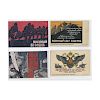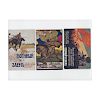Imperial Russian Propaganda, 5½ % War Loan, 1916
About Auction
Sep 30, 2016 - Oct 27, 2016
Rare Paper info@rare-paper.com
- Lot Description
Complete set of 27 lithography postcards.
Dimensions: 9 x 14 cm, 9,5 x 14.2 cm
About War Loan:
Many talented artists, including those closely associated with the State Bank Department of State Securities (engaged in the production of banknotes and securities in the Russian Empire), created artworks for the War Loan postcards and posters.
The figure of Richard Germanovich Zarrin (1869-1939), designer of Russian banknotes, stamps, and posters, stands out among collectors. He was a native of the town Knegali in Livonia (Latvian spelling of his last name - Zarins). After graduating from the German School in Dvinsk (now Daugavpils), he enrolled in the Central School of Technical Drawing in St. Petersburg, where he studied from 1887 to 1895. This educational institution was created by the first money manager of the State Bank, Baron Alexander von Stieglitz. Here the artist received excellent training, supplemented by internships in private engraving workshops in Munich (1896), as well as in the studio of the etcher, B. Unger, in Vienna (1897-1898).
In 1899 Zarrin started working as an artist in the engraving and art department of Expedition Harvested Government Securities, and soon became a senior assistant in the artistic and technical department. He helped the artist G. I. Frank who was invited to Expedition from Vienna.
In 1905, Zarrin became technical director of Expedition. During 1908-1909, he made sketches of state bank notes for 100-ruble (sample 1910) and 500-ruble (sample 1912) denominations, which were approved by Nicholas II. The artist was also engaged in book design and illustration for magazines, stamps, and posters.
By order of the Provisional Government Zarrin produced a sketch of a postage stamp "Russian Liberation," already released under the new government in 1918, and known as the first Soviet stamp. In the spring of 1919, he returned to Latvia, where he became one of the first Latvian ex-libris artists. He created mostly etchings (mainly on folklore and historical subjects), and drawings, colored lithographs and watercolors. In the years 1919-1933 Zarrin was a manager of typography in Riga, teaching at the Art Academy of Latvia (1919-1936), where he led a workshop in graphics and received the academic rank of professor in 1934. During this time (1921) he designed a national emblem for the Latvian government.
Zarrin was an author of at least four different posters and postcards about the war loan. One of these postcards (Postcard №22) depicts a knight raising the fighters in an attack. The inscription on the postcard leaves no choice: "Who does not reflect the enemy with his chest, must buy the War Loan." On the other postcard (Postcard №23) – a mechanic who grinds an artillery shell reads the laconic inscription: "Patriotic and Profitable!" There are two other postcards (Postcard №20, 21) in the same style – one showing a heroic helmet and a sword, the second showing a symbol of the Russian Empire, the double-headed eagle with ribbons.
Alfred R. Eberling (1871-1951) was also invited to create posters and postcards. Born in the Polish town of Zgierz, he received his artistic education at the Higher Art School of Painting, Sculpture and Architecture at the Imperial Academy of Arts (1899-1900). After this, he trained with the famous German artist F. Lenbach in Munich. Eberling spent most of his life in St.Petersburg. In the years 1924-1925, he completed a portrait of Lenin, which was later engraved on a series of gold coins in 1937. Eberling was the author of the postcard (Postcard №24) with an image of combat aircraft and bore the inscription: "Sign up for the War Loan - Make Your Way to Victory."
Efim Cheptsov (1874-1950), working in the Soviet era, was the author of a spectacular postcard (Postcard №25) with an image of the military preparing a canon in the background.
Postcards were also done in the realistic style, much like Cheptsov, by Ivan Vladimirov, Gregory Semenov, Sigizmund Vidberg, Michael Olkone and Vladimir Varzhanskiy.
At that time there were also postcards created in the national romantic style, e.g. The postcard (Postcard №26) by the artist Jankowsky depicting St. George, striking a snake. Another (Postcard №27) by Alexey Maksimov designed in the same style, shows the hero on a horse with a banner in his hands on which appears a double-headed eagle.
The War Loan postcards, due to their high artistic level, won the love of the people. In 1917, The Department of Posts and Telegraphs released a series of non-postal stamps on the same subjects carried by posters and postcards. The stamps were used by the Petrograd conductors, in place of small change for travel on trams.
It is difficult to say how much the posters and postcards influenced the success of the loan (revenue for the first issue was 1.5 billion, and for the second - 1.6 billion rubles). At least, the series provides the best examples of foreign postcard and poster propaganda during WWI.
- Shipping Info
-
Shipping info
All purchased item(s) will be professionally packed before shipping. We send item(s) by registered mail with a tracking number (USPS - Priority Mail) within 7 days. Let us know if you prefer other shippers or couriers, such as UPS, FEDEX or DHL. International buyers are responsible for all import/export customs duties and taxes. An invoice stating the actual purchase price will accompany all international purchases.
-
- Buyer's Premium



 EUR
EUR CAD
CAD AUD
AUD GBP
GBP MXN
MXN HKD
HKD CNY
CNY MYR
MYR SEK
SEK SGD
SGD CHF
CHF THB
THB




















